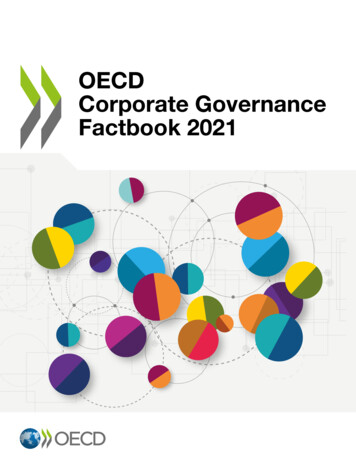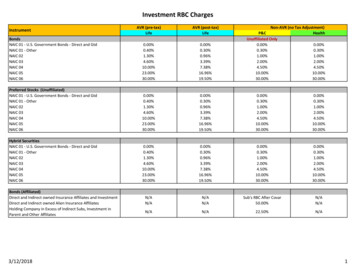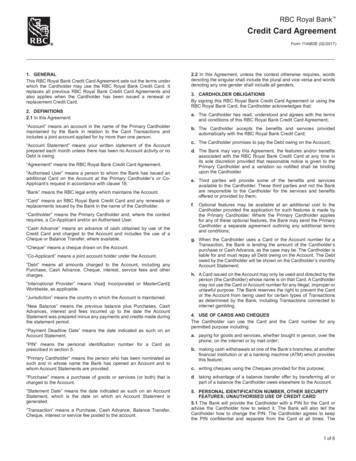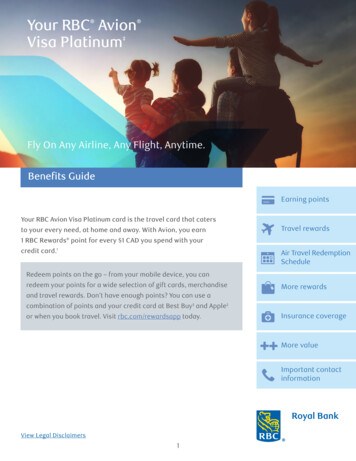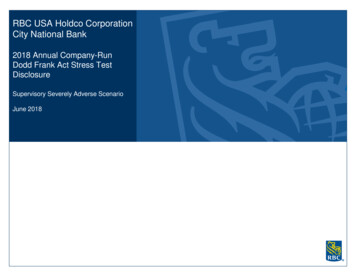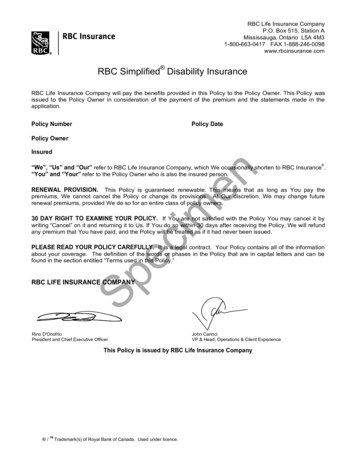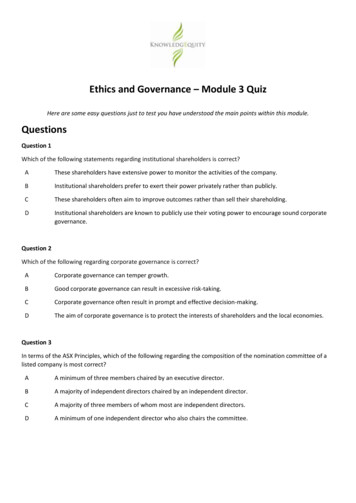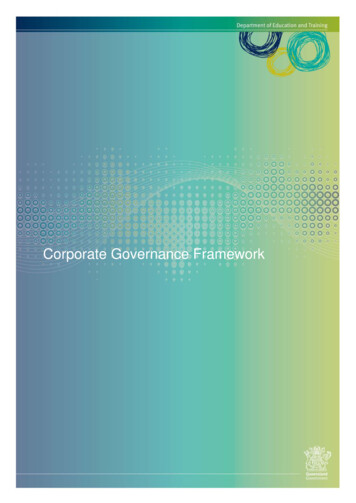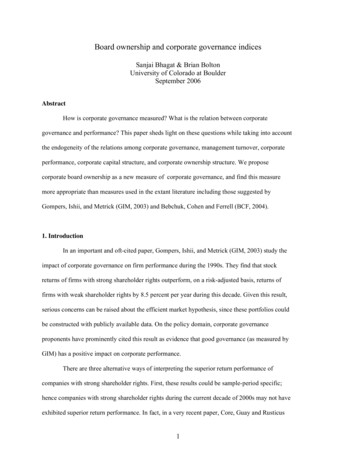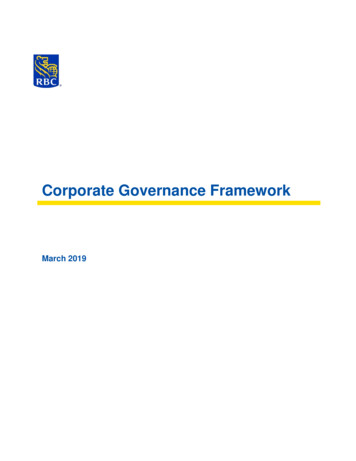
Transcription
Corporate Governance FrameworkMarch 2019
Table of contents1.2.3.4.5.6.7.8.9.10.11.Our approach to governance . 3The core principles that drive our approach . 3Our governance structure . 5Role of the board . 5Role of the board chair . 6Committees of the board . 7Committee chairs . 7Audit committee . 8Risk committee . 8Governance committee . 9Human resources committee. 9External advisors . 9The role of management . 10Group Executive . 10Oversight functions . 10Reporting and escalation of significant issues to the audit committee and risk committee . 11Disclosure controls and certifications . 11Conduct and culture . 12Our Code of Conduct . 12Conflicts of interest . 13Our commitment to diversity . 13Board composition . 14Board size . 14Independence of the board . 14Interlocking directorships . 15Finding the right director candidates . 15Majority voting. 17Tenure policy . 17Board operations . 18Meeting attendance . 18Director orientation and continuing education . 18Assessments of effectiveness . 19Director compensation . 20Engaging with shareholders and other stakeholders . 21Interaction with regulators . 21Approval, responsibility and review schedule . 21
Corporate Governance Framework1.Our approach to governanceThis framework provides an overview of the corporate governance structures, principles, policies andpractices of the Board of Directors (the board) of Royal Bank of Canada (RBC or the Bank), whichtogether enable RBC to meet governance expectations of the Office of the Superintendent of FinancialInstitutions Canada (OSFI), the Canadian Securities Administrators (CSA) and the U.S. Securities andExchange Commission (SEC).We are committed to high standards of governance that are consistent with regulatory expectations andevolving best practices and that are aligned with our strategy and risk appetite. We believe that goodgovernance is not just about overseeing RBC and its practices, but doing so in a way that’s transparent,independent of management and ethical. It involves the board actively engaging with all stakeholders,knowing the business and its risks, challenging management where necessary, understanding thechallenges and opportunities of a changing industry and economy, setting robust standards and principlesthat will guide RBC to success and helping clients strive and communities prosper – all to ensure we’reconstantly enhancing value for our shareholders. This is what your board aims at every day.To serve the interests of shareholders and other stakeholders, RBC’s corporate governance system issubject to ongoing review, assessment and improvement. The board proactively adopts governancepolicies and practices designed to align the interests of the Board and management with those ofshareholders and other stakeholders and to promote the highest standards of ethical behaviour and riskmanagement at every level of the organization.RBC Common Shares are listed on the Toronto Stock Exchange (TSX), the New York Stock Exchange(NYSE) and the Swiss Exchange. The board exercises its authority in accordance with the RBC Code ofConduct, its By-laws and the Bank Act, as well as other applicable laws and regulations, including thoseof the CSA, the TSX, the NYSE and the SEC.RBC’s practices are consistent with Bank Act requirements, the OSFI Corporate Governance Guideline,the CSA’s corporate governance guidelines (CSA Guidelines) and the CSA’s rules and applicableSEC rules relating to audit committees. In addition, although RBC is not required to comply with most ofthe corporate governance listing standards of the NYSE (NYSE Rules) applicable to U.S. domesticissuers, RBC meets or exceeds the NYSE Rules in all significant respects except as summarized onRBC’s governance website.2.The core principles that drive our approachRBC’s approach to corporate governance is guided by the following core principles:PrincipleDescriptionBy setting the tone from above, the board champions the values of trust, integrity andgood governance.Conduct andCultureThese values are well entrenched in the culture of RBC and reinforce the ethicalprinciples on which RBC’s reputation and success are founded. To maximizeshareholder value on a sustainable basis, these values must extend into everysegment of RBC operations and business activities.3
Corporate Governance FrameworkPrincipleDescriptionDirectors are the stewards of RBC, exercising independent judgment in overseeingmanagement and safeguarding the interests of shareholders.StewardshipIn fulfilling its stewardship role, the board seeks to instill and foster a corporateenvironment founded on integrity and to provide management with sound guidancein pursuit of long-term shareholder value.Directors are key advisors to management, advising on strategic direction, objectivesand action plans, taking into account business opportunities and RBC’s risk appetite.StrategicOversightIn carrying out this oversight role, the board actively engages in setting the long termstrategic goals for the organization, reviews and approves business strategies,corporate financial objectives and financial and capital plans that are consistent withthe strategic goals, and monitors RBC’s performance in executing strategies andmeeting objectives.The board oversees the frameworks, policies and systems to identify and managerisks to the businesses, and seeks to embed a strong risk management culturethroughout RBC.Risk OversightIndependenceAccountabilityThe board actively monitors the organization’s risk profile relative to risk appetite andseeks to ensure that management’s plans and activities provide an appropriatebalance of return for the risks assumed and are prudently focused on generatingshareholder value.Independence from management is fundamental to the board’s effective oversight,and mechanisms are in place to ensure its independence.All direct and indirect material relationships with RBC are considered in determiningwhether a member of the board is independent.Transparency is a hallmark of good governance. The board is committed to clear andcomprehensive financial reporting and disclosure, and constructive shareholderengagement.The board has carefully defined the expectations and scope of duties of the board,its committees and management.The board is committed to continuously improving its corporate governanceprinciples, policies and practices.ContinuousImprovementRBC’s approach to corporate governance is designed to align the interests of theboard and management with those of shareholders, to support the stewardship roleof the board and to enhance the board’s ability to safeguard the interests ofshareholders through independent supervision of management.To ensure policies and practices meet or exceed evolving best practices andregulatory expectations, RBC’s corporate governance system is subject to ongoingreview by the governance committee.4
Corporate Governance Framework3.Our governance structureOur governance structure establishes the fundamental relationships among the board, its committees,management, shareholders and other stakeholders.We set our ethical values and our strategic and corporate objectives, and we determine our plans forachieving and monitoring performance through this structure.4.Role of the boardThe board is responsible for the overall stewardship of RBC and fulfills this responsibility by overseeingmanagement and aiming to enhance long-term shareholder value. Directors are elected by theshareholders to supervise management of the business and affairs of the organization with the goal ofenhancing long-term shareholder value.5
Corporate Governance FrameworkThe board’s role consists of two fundamental elements: decision-making and oversight. The decisionmaking function is exercised through the formulation with management of fundamental policies andstrategic goals and the approval of certain significant actions. The oversight function concerns the reviewof management decisions, the adequacy of systems and controls and the implementation of policies. Theboard makes major policy decisions, participates in strategic planning, delegates to managementauthority and responsibility for day-to-day affairs and reviews management’s performance andeffectiveness.The Bank Act specifies certain important matters that must be dealt with by the board, such as approvalof financial statements and declarations of dividends. By formal resolution, the board reserves for itselfthe authority to make certain decisions and delegates others to management. Any responsibilities notdelegated to management remain with the board and its committees. In some matters, management’sdiscretion is limited by dollar thresholds beyond which approval by the board is required. For example,such thresholds exist for investments and divestitures, decisions relating to mergers and acquisitions,intra-group transactions, operating expenditures, capital and funding and project initiatives.The board’s functions are fully described in its charter, which is approved by the board. The specificresponsibilities of the board are described in the RBC Annual Report and Management Proxy Circularand include the following matters:5. fostering a culture of integrity and good governance; strategic planning; identifying risks and overseeing risk management; overseeing financial reporting, internal controls, communications and public disclosure; succession planning and evaluating performance and approving compensation of seniormanagement; and establishing corporate governance structures, principles and practices that contribute to effectiveoversight of RBC and its subsidiaries.Role of the board chairThe board chair is an independent director who leads the board and shareholder meetings and isresponsible for the management, development and effective functioning of the board. The board chairdoes not serve as a member of any Board committee but attends and participates at committee meetings.The board chair has unrestricted access to management, as well as the authority to engage, at theexpense of RBC, independent advisors, including legal counsel, and to approve the fees and terms oftheir engagement. Tenure of the board chair is eight years, with a review after five years to plan fororderly succession, subject to annual re-appointment by the board.The board chair works closely with the governance committee on such key matters as: advises the CEO on major issues and liaises between the board and senior management; participates in the orientation of new directors and the continuing development of currentdirectors;6
Corporate Governance Framework with the governance committee, conducts the board’s effectiveness evaluation and plans boardsuccession and recruitment; interacts with directors and senior executives throughout the year; meets with regulators, shareholders and stakeholders on behalf of the board; and meets periodically with independent directors of our subsidiaries.The board reviews and approves the board chair’s mandate, while the governance committee, under thedirection of its chair, annually assesses the effectiveness of the board chair in fulfilling her mandate.6.Committees of the boardTo assist in exercising its responsibilities, the board has established four committees: audit committee risk committee governance committee, and human resources committee.The governance committee recommends committee membership and successors of the board chair andcommittee chairs. The governance committee also oversees board renewal and nominates directors forelection or re-election. During their tenure as directors, they would normally serve on a committee for aminimum of three years, and most of them serve on every committee.The committee chair reports to the board following each committee meeting, and makes suchrecommendations as are deemed appropriate in the circumstances.Each committee has a written mandate that sets out its responsibilities and qualifications for committeemembership under applicable laws and regulations. The governance committee reviews the board andcommittee mandates, which outline their areas of responsibility, and allocates responsibilities as required,taking into account regulatory guidance and industry best practices. These reviews ensure the board andits committees are adaptive and responsive to new requirements and continue to practice strongoversight.Each committee annually assesses its effectiveness to ensure that it has effectively fulfilled itsresponsibilities as set out in its mandate. The chair of each committee, in consultation with the committeemembers and senior management, develops work plans for the year, which provide a thematic view ofthe forward agenda and are intended to focus the committee on the most important aspects of itsmandate with sufficient frequency.Each committee prepares a report on an annual basis of its activities over the previous year. Thesereports, as well as details about the composition and responsibilities of each committee, are includedannually in the Management Proxy Circular.Committee chairsEach committee is comprised entirely of independent directors and is chaired by an independent directorwho is responsible for the effective operation of the committee and the fulfillment of the committee’s7
Corporate Governance Frameworkmandate. The board has approved a written position description for each committee chair. To facilitateopen and candid discussion among committee members, each committee chair regularly leads in-camerasessions without management present.Tenure of committee chairs is three years of continuous service, subject to annual re-appointment by theboard. Where appropriate, the governance committee may recommend that the board extend tenurebeyond three years for a further period of up to two years, having regard to the expertise required forleadership of the relevant committee.Audit committeeManagement of RBC is responsible for the preparation, presentation and integrity of the financialstatements and for maintaining appropriate accounting and financial reporting principles, policies, internalcontrols and procedures designed to ensure compliance with accounting standards and applicable lawsand regulations. The external auditor is responsible for planning and carrying out, in accordance withprofessional standards, an audit of the annual financial statements and an audit of internal control overfinancial reporting. The external auditor also reviews the quarterly financial information. The auditcommittee’s purpose is to review the adequacy and effectiveness of these activities and to assist theboard in its oversight of: the integrity of the Bank’s financial statements; the external auditors’ qualifications, independence and performance; the effectiveness and independence of the Bank’s Internal Audit Services, Finance andCompliance functions; the adequacy and effectiveness of internal controls; and the Bank’s compliance with legal and regulatory requirements.Each member of the audit committee must be independent and “financially literate” within the meaning ofthe rules of the CSA relating to audit committees and the corporate governance listing standards of theNYSE. In accordance with applicable regulatory requirements at least one member must have accountingor related financial management expertise, as the board interprets such qualification in its businessjudgment. Members of the audit committee may serve on the audit committees of no more than threepublic companies, including RBC.Risk committeeThe risk committee is responsible for overseeing risk management at RBC, balancing risks and rewardswhile ensuring that management has in place policies, processes and procedures designed to identifyand effectively manage the significant risks to which RBC is exposed. Annually, the risk committeereviews and recommends to the board for approval RBC’s Enterprise Risk Appetite Framework, which isthe amount and type of risk RBC is willing to accept in the pursuit of its business objectives. Thecommittee also reviews regular reporting on the assessment of RBC’s risk profile as measured againstthe approved risk appetite.The risk committee annually reviews and approves RBC’s comprehensive Enterprise Risk ManagementFramework, which provides a consolidated overview of the Bank’s program for identifying, measuring,controlling and reporting on the significant risks that face the organization. The risk committee alsoassists the board in its oversight of the effectiveness and independence of RBC’s risk managementfunction.8
Corporate Governance FrameworkGovernance committeeThe governance committee is the nominating committee responsible for recommending to the boardindividuals qualified to become directors. The governance committee oversees the board’s effectivenessevaluation process. The governance committee is responsible for advising the board in applyinggovernance principles, monitoring developments in corporate governance and adapting best practices tothe needs and circumstances of RBC. The governance committee also advises the board on relationshipswith governments, and has oversight of RBC’s approach to corporate citizenship.The governance committee fulfills the role of a conduct review committee for RBC and ensures thatmanagement has established practices and procedures relating to self-dealing, insider trading andpersonal loans, as required by law. It monitors procedures to resolve conflicts of interest, reviews andapproves the RBC Code of Conduct and obtains assurances that RBC has processes in place to ensureadherence to the Code.Human resources committeeThe human resources committee acts as the compensation committee of the board. This committee isresponsible for advising the board on succession planning, compensation and human resources policiesand practices, as well as compensation risk management. It also provides its recommendation to theboard for compensation of the president and chief executive officer (CEO) in light of the evaluation of hisperformance against approved goals and objectives relevant to his compensation.The human resources committee annually reviews executive talent development strategies, successionplans for key senior leadership roles and readiness of the Bank’s executive talent to deliver strategicgoals of RBC. In addition, the human resources committee makes recommendations to the board on thecompensation of senior management and on matters concerning the Bank’s pension plans.The human resources committee meets privately with an external compensation consultant, withoutmanagement present, at each of its meetings where executive compensation is discussed.External advisorsCommittees may engage external advisors at the expense of RBC. The committees have sole authority toretain, and approve the fees of, any external consultants or other external advisors that they determine tobe necessary to carry out their duties.Prior to engaging an external advisor, the human resources committee must consider certain factorsarising from the NYSE Rules, which may impact the advisor’s independence, in particular: other services provided to RBC by the advisor’s firm the amount of fees received from RBC by the advisor’s firm as a percentage of that firm’s totalrevenues policies and procedures of the advisor’s firm that are designed to prevent conflicts of interest the extent of relationships of the advisor or the advisor’s firm with members of the humanresources committee or with executive officers of the Bank, and any RBC securities owned by the advisor.9
Corporate Governance Framework7.The role of managementThere is a clear demarcation of roles and responsibilities between the board and senior management thatfosters an environment of transparency, confidence and mutual trust in which the board is able toconstructively challenge and provide guidance to management.Group executiveSubject to the provisions of the Bank Act, the board may appoint such officers and specify such dutiesand delegate such powers to them as the board may determine. The board has established the groupexecutive comprised of the CEO, the group heads, the chief financial officer (CFO), the group chief riskofficer (GCRO), the chief human resources officer, the chief administrative officer and the head ofStrategy and Corporate Development. Each group executive member leads a senior operatingcommittee.The board delegates to senior management the authority and responsibility for day-to-day affairs andreviews senior management’s performance and effectiveness. Senior management is accountable forimplementing the board’s decisions, and is responsible for directing and overseeing the operations of theBank. The CEO and group executive member have written mandates describing their respective roles,responsibilities and required capabilities of their positions.The group executive is responsible for RBC’s strategy and its execution. The group executive activelyshapes and recommends RBC’s risk appetite for approval by the risk committee and the full board. Thegroup executive’s risk oversight role is executed primarily through the mandate of the group riskcommittee (GRC). GRC, with the assistance of its supporting senior management risk committees, isresponsible for ensuring that RBC’s overall risk profile is consistent with its strategic objectives andapproved risk appetite and that there are ongoing appropriate and effective risk management processes.Oversight functionsThe group executive delegates some of its responsibilities to RBC’s oversight functions, consisting ofFinance, Group Risk Management, Compliance, and Internal Audit, which are responsible for providingenterprise-wide oversight of operational management. The heads of these functions have direct access tothe audit committee and/or risk committee (as appropriate) and report to the CEO or to the head ofanother oversight function.The board, through the audit committee and the risk committee, are responsible for overseeingeffectiveness of the oversight functions and the heads of these functions. The mandate of the auditcommittee sets out specific responsibilities for overseeing Finance, Compliance and Internal AuditServices and the mandate for the risk committee similarly sets out responsibilities for overseeing theGroup Risk Management.As Internal Audit Services is responsible for providing independent assurance to the audit committee andto senior management on the effectiveness of risk management processes, governance and systems ofinternal control at RBC, the chief audit executive (CAE) reports directly to the audit committee chair forfunctional purposes and to the CEO for administrative purposes.The heads of the Finance, Compliance and Group Risk Management oversight functions have direct andregular access to the relevant board committee through its chair. In addition, the audit committee holdsseparate private meetings with each of the CAE, the CFO, the chief compliance officer (CCO), the chiefanti-money laundering officer (CAMLO) and the general counsel on a quarterly basis with no othermembers of management present. The risk committee meets privately with the GCRO at every regularlyscheduled meeting, with no other members of management present.10
Corporate Governance FrameworkOn an annual basis the effectiveness of the oversight functions and the heads of the functions areassessed by the relevant committee. Each assessment includes a review of the mandates of the functionand function head, the function’s budget and resources, the organizational structure and independencefrom operational management.Third party reviews of the oversight functions are conducted every five years on a rotating basis, or asotherwise determined by the board.Reporting and escalation of significant issues to the audit committee and risk committeeRegular reports are provided to the audit and risk committees, as appropriate, on significant matters, bythe General Counsel, the CAMLO, the CCO, the CAE, the CFO and the GCRO.The board has in place a policy that provides guidance regarding timely communication and reporting bysenior officers of RBC of control deficiencies and other significant issues to the audit committee or the riskcommittee through the chairs of these committees.Disclosure controls and certificationsRBC has in place disclosure controls and procedures that are designed to ensure that materialinformation relating to RBC is communicated to RBC’s senior executives, including the CEO and theCFO, and to the disclosure committee.The disclosure committee, comprised of senior management, assists the CEO and CFO in ensuring thereis an adequate and effective process for establishing, maintaining and evaluating disclosure controls andprocedures for RBC’s external disclosures.Internal control over financial reporting is a process designed to provide reasonable assurance regardingthe reliability of financial reporting and the preparation of financial statements for external purposes inaccordance with generally accepted accounting principles. Senior management, with the assistance ofthe disclosure committee, is responsible for establishing and maintaining adequate internal control overfinancial reporting, as well as annually evaluating the effectiveness of these controls.Annually and quarterly under U.S. certification rules, the CEO and CFO certify that they: are responsible for establishing and maintaining disclosure controls and procedures and internalcontrol over financial reporting; designed (or caused the design of) and evaluated the disclosure controls and procedures andreported their conclusions about the effectiveness of the disclosure controls and procedures inpublic
1. Our approach to governance This framework provides an overview of the corporate governance structures, principles, policies and practices of the Board of Directors (the board) of Royal Bank of Canada (RBC or the Bank), which together enable RBC to meet governance expectations of the Office of the Superintendent of Financial
